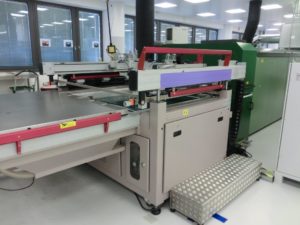 The purpose of screen printing equipment, or rather, the type of final product, determines the requirements for equipping such a site. Ultimately, the type of material to be printed determines everything.
The purpose of screen printing equipment, or rather, the type of final product, determines the requirements for equipping such a site. Ultimately, the type of material to be printed determines everything.
The most “demanding” in this respect decal production, using special rubberized paper, so the microclimate plays a dominant role. Equally important in this respect is the equipping of printing stations on panels of auto-mobile devices and the manufacture of printed circuits.
Screen Printing Equipment Operation
The least demanding varnishing areas, the location of which (undesirable, of course) is possible in a heated garage.
It should be taken into account that the large thickness of the ink layer on the impression (up to 100 μm) determines the requirements for the drying of the impressions.
Typically, the screen machine is aggregated with a drying device, which is selected depending on the method of fixing the ink used on the impression. This forms a production line, the final point of which is the receiving device – the stacker.
Each of the elements of the production line is supplied assembled, so the installation task is the connection and coordination of its individual devices. In this case, it should be taken into account that the drying process requires intensive air exchange, in other words, exhaust ventilation at the stencil site is a necessary thing.
The training of printing specialists for the maintenance of the machine usually takes place during the installation, which is enough to acquire skills for independent work on local varnishing, as well as one – two-color printing at operating speeds in compliance with the requirements for combining. The main thing is to choose the brand and type of screen printing equipment. And here are all the possible options.
Principles of Work on Screen Printing Equipment
Preparation of sheet stencil machines for printing consists of the following operations:
1. Preparation of sheet-feeding, sheet-feeding, and receiving-output devices; the technique corresponds to the standard set of sheet printing machines;
2. Preparation of the printing device – installation and pre-registration of the printing plate, adjustment of the gap between the form and the printed material, the squeegee setting and adjustment of its pressure and inclination angle; loading the paint spraying system with paint and adjusting its supply to the mold;
3. Accurate register;
4. Preparation of drying devices – adjustment of air temperature in the drying chamber and intensity of air exchange.
After fixing, they start printing the print run.
Necessary conditions for printing a stable quality circulation:
• Calculation and maintenance of a necessary backlash between the form and a printed matter,
• Constant pressure of the squeegee along the entire length of the stroke of the printing plate,
• Constant speed of printing,
• reliable fixation of the printed material on the printing surface,
• stability of the ink’s “behavior” when printing the entire print run,
• the optimum mode of drying of impressions.
Paints for Screen Printing Equipment
The paints used in screen printing differ in the way they are fixed on the impression:
– due to the oxidative polymerization of the binder;
– by evaporation of the solvent;
– due to the chemical interaction of the hardener with binders;
– due to curing by UV rays.
Advantages and Disadvantages of Paints
• The advantages of paints fixed by the oxidative polymerization of the binder include: low toxicity, no sharp odor and good adhesion to different surfaces. Paints form a colorful film of satisfactory strength and good elasticity. The time of fixing the colors of this group under natural conditions is several hours, and the increase in the drying temperature does not give a significant effect.
Paints fixed by the oxidative polymerization of the binder have a fastening time of several minutes to several hours and therefore can only be used when printing on manual or semi-automatic machines.
• Paints fixed by evaporation of a volatile solvent contain, as a film-forming agent, most often various cellulose ethers. The type of cellulose ether depends on the physical and mechanical properties and adhesion of the colorful film to various materials. The colors of this group for printing on polymer materials are characterized by high strength and fast fixing. When the surfaces of synthetic products interact with the solvents that form part of the stencil paints, some dissolution or swelling occurs. This ensures the adhesion strength of the ink film to the surface to be printed.
At the present time, paints fixed by evaporation of volatile solvents have become most widespread, and the time of their fixing ranges from several seconds to several minutes. Paints and varnishes of this group are used both for printing on manual and semi-automatic machines and on automatic machines with drying devices.
Paints containing water as a solvent, with their ecological safety for printing on paper and cardboard, have certain difficulties in the application: they require a special copy layer, in addition, the colors often dry out on the mold, which increases the laboriousness of their use.
• Paints fixed by the chemical interaction of the hardener with binders, so-called two-component, for example, epoxy-based, form on the impression a high-strength layer resistant to the action of various aggressive media. Their disadvantage is a short (several hours) period of use after the curing agent is injected into them.
• UV curing inks and lacquers contain a photopolymerizable composition as a binder. They have good adhesion to most of the sealed materials and form high-strength impressions. They do not dry on the mold and are therefore quite technological in the printing process.
Thank you for reading our articles, stay informed about the industrial world and Exapro by following us on Exapro Hub, Facebook, Twitter, and LinkedIn.



